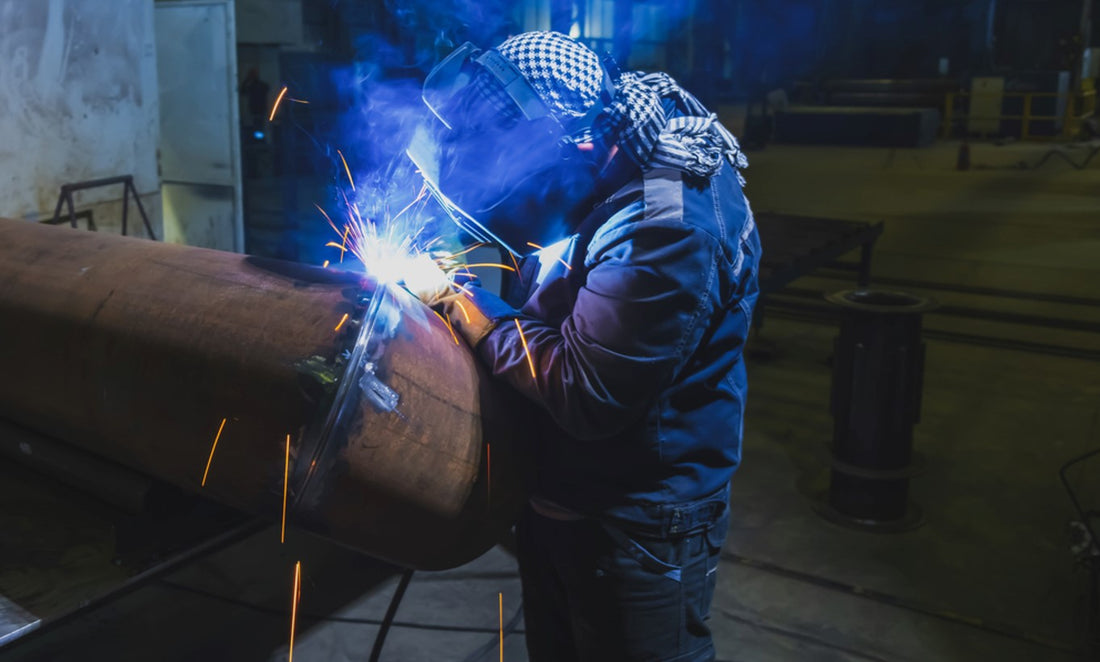Hardfacing MIG wire, also known as hard surfacing, is most commonly used in industrial settings to repair damaged or destroyed machines, vehicles, bridge work, etc.
There are a lot of great benefits associated with using this type of wire while MIG welding, providing a durable, sustainable connection between two sheets of metal or a layer of protection to the piece.
While the process is relatively simple, it can be confusing to understand initially, so we put together this guide for hardfacing MIG wire.
What Is Hardfacing MIG Wire?

A MIG welding wire is used in a MIG welding machine to bind two pieces of metal together or to apply a layer of protective metal to a fresh weld or metal part. This type of wire is considered a filler metal fed through the device, melted, and applied to the material requiring a weld.
As the melted wire cools, it solidifies, providing a strong, firm, and durable hold. This wire is made from various materials in different forms and sizes.
To save time and get straight to the point, we will not review the extensive MIG wires library and focus on hardfacing options.
Hardfacing MIG Wire
Hardfacing MIG wire is typically used to repair or rebuild damaged parts on machines and other metal surfaces. This protects or reinforces metal objects to extend their life, limiting the amount of wear and tear they sustain.
When you think of welding, your brain probably automatically goes to bonding two metal sheets together. While hardfacing wire can handle that task with no trouble, it is often used to fill holes, reinforce cracked or damaged materials, or offer a layer of protection to flimsy or delicate products.
This specific type of welding wire is used in many industries, especially those looking for a strong and long-lasting bond.
Some of the most common areas where you will see hardfacing MIG wire used are:
- Cement
- Coal and mining industry
- Petrochemical
- Construction
- Sugarcane and food
- Marine and maritime industry
- Metal and metalworking industry
- Power and generation industry
- Shipyard and shipbuilding industry
Types of Hardfacing MIG Wire
The purpose behind using MIG wire is often the same, no matter what job, repair, or DIY project you are working on. However, the metal you use on that task will require a specific kind of hardfacing wire.
Solid and Flux Core Hardfacing MIG Wire
First, we want to talk about the two forms of hardfacing MIG wire: flux core and solid wire.
- Flux Core: Flux core wire is made of a solid metal tube with a flux core The flux protects your metal while it cools by creating a protective barrier. Once the weld is cooled down, the flux can be chipped away, revealing a nice hard seal.
- Solid Hardfacing Wire: This type of wire is typically made from a metal alloy. The metal wire must be more rigid than the base metal for it to work.
Numerous types of base metals are commonly used, including:
- Cast iron
- Stainless steel
- Copper-based alloys
- Nickel-based alloys
- Carbon and alloy steel
- Manganese steels
Each of these metals is ideal for hardfacing MIG wire because they are typically softer than the composition of the wire.
The Most Commonly Used Hardfacing MIG Wire
Hardfacing MIG wire can be composed of various materials, yet when working on a hardfacing task, a few options stand out amongst the rest. These options include:
- Cobalt and nickel
- Cobalt and nickel with a flux core
- Iron base hardfacing wire
- Solid copper core
- Tungsten carbides
- Hard base wire
- Metal cored
Types of Rods Used With Hardface MIG Wires
The type of rod you use with your hardface wire will also look different depending on what you are doing and what type of material is your base metal.
To start things off, copper-based hardface welding rods are one of the better options when using the wires listed above. Aside from copper, you could also easily use iron base and nickel + cobalt base.
Type of MIG Welder for Hardface Welding Wire
You can choose from an automatic to semi-automatic MIG welding machine when using hardface welding wire. Both options will work well and get the job done, providing a durable, strong, and long-lasting hold on any project.
Semi-automatic and automatic machines can use the same type of wires and distribute them similarly.
One of the best parts about using a MIG welder with MIG wire is that the material is often more affordable than other options.
Tips for Hardfacing MIG Welding Wire

A few tips and tricks for using hardfacing MIG welding wire can help just about anyone achieve the perfect weld every time.
- Stick to recommended preheat ranges. Do not allow your MIG wire to preheat for an extended period. Follow the instructions provided by the manufacturer.
- Properly prepare all surfaces before applying hardface weld. Thoroughly clean the metal surface you are preparing to weld. Remove all dirt, debris, oil, grease, and other contaminants from the product to get the best coverage and hold. If a hardface was already used in that space, remove it before applying another layer.
- Remove fragile, corroded, or thinning metal before welding. To avoid welding beads or other impurities, it is crucial to remove severely rusted, corroded, or loose material.
A hardfacing wire is only as good as the base metal it is matched with. You must ensure that the surface you work on is prepped and ready for additional metal layers.
Final Thoughts
There are various wire options for hardface MIG welding that will provide a strong hold and protective seal. To ensure you choose the perfect MIG hardfacing wire, review the guide above to familiarize yourself with the criteria required to meet hardfacing standards for those tough welding jobs.

